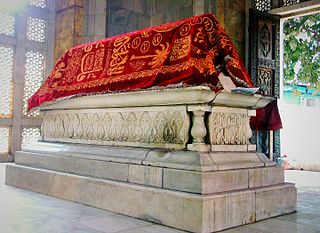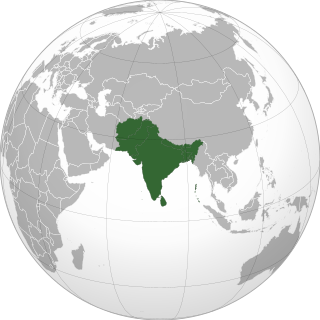
The Delhi Sultanate or the Sultanate of Delhi was a late medieval empire primarily based in Delhi that stretched over large parts of the Indian subcontinent for more than three centuries. The sultanate was established around c. 1206–1211 in the former Ghurid territories in India. The sultanate's history is generally divided into five periods: Mamluk (1206–1290), Khalji (1290–1320), Tughlaq (1320–1414), Sayyid (1414–1451), and Lodi (1451–1526). It covered large swaths of territory in modern-day India, Pakistan, Bangladesh, as well as some parts of southern Nepal.

The Kakar is a Gharghashti Pashtun tribe, based in Afghanistan, parts of Iran, and northern Balochistan in Pakistan.

Mu'izz al-Din Muhammad ibn Sam, also known as Muhammad of Ghor or Muhammad Ghori, was a ruler from the Ghurid dynasty based in the Ghor region of what is today central Afghanistan who ruled from 1173 to 1206. Muhammad and his elder brother Ghiyath al-Din Muhammad ruled in a dyarchy until the latter's death in 1203. Ghiyath al-Din, the senior partner, governed the western Ghurid regions from his capital at Firozkoh whereas Muhammad extended Ghurid rule eastwards, laying the foundation of Islamic rule in South Asia, which lasted after him for nearly half a millennium under evolving Muslim dynasties.
Ghauri, Ghori, Ghouri, or Ghuri may refer to:

Qutb ud-Din Aibak was a Turkic general of the Ghurid emperor Mu'izz ad-Din Muhammad Ghori. He was in charge of the Ghurid territories in northern India, and after Muhammad Ghori's assassination in 1206, he established his own independent rule in Lahore, and laid the foundations for the Sultanate of Delhi.

The Ghiljī also spelled Khilji, Khalji, or Ghilzai and Ghilzay (غلزی), are one of the largest Pashtun tribes. Their traditional homeland is Ghazni and Qalati Ghilji in Afghanistan but they have also settled in other regions throughout the Afghanistan-Pakistan Pashtun belt. The modern nomadic Kochi people are predominantly made up of Ghilji tribes. The Ghilji make up around 20–25% of Afghanistan's total population.
The Ghurid dynasty was a Persianate dynasty of eastern Iranian Tajik origin, which ruled from the 8th-century in the region of Ghor, and became an Empire from 1175 to 1215. The Ghurids were centered in the hills of the Ghor region in the present-day central Afghanistan, where they initially started out as local chiefs. They gradually converted to Sunni Islam after the conquest of Ghor by the Ghaznavid ruler Mahmud of Ghazni in 1011. The Ghurids eventually overran the Ghaznavids when Muhammad of Ghor seized Lahore and expelled the Ghaznavids from their last stronghold.

The Bareilly district belongs to the state Uttar Pradesh in northern India. Its capital is Bareilly city and it is divided in six administrative division or tehsils: Aonla, Baheri, Bareilly city, Faridpur, Mirganj, and Nawabganj. The Bareilly district is a part of the Bareilly Division and occupies an area of 4120 km2 with a population of 4,448,359 people according to the census of 2011.

The Muslim conquests in the Indian subcontinent mainly took place between the 13th and the 18th centuries, establishing the Indo-Muslim period. Earlier Muslim conquests in the subcontinent include the invasions which started in the northwestern subcontinent, especially the Umayyad campaigns during the 8th century. Mahmud of Ghazni, Sultan of the Ghaznavid Empire, preserved an ideological link to the suzerainty of the Abbasid Caliphate and invaded vast parts of Punjab and Gujarat during the 11th century. After the capture of Lahore and the end of the Ghaznavids, the Ghurid ruler Muhammad of Ghor laid the foundation of Muslim rule in India in 1192. In 1202, Bakhtiyar Khalji led the Muslim conquest of Bengal, marking the easternmost expansion of Islam at the time.

Ikhtiyār al-Dīn Muḥammad Bakhtiyār Khaljī, also known as Bakhtiyar Khalji, was a Turko-Afghan military general of the Ghurid ruler Muhammad of Ghor, who led the Muslim conquests of the eastern Indian regions of Bengal and parts of Bihar and established himself as their ruler. He was the founder of the Khalji dynasty of Bengal, ruling Bengal for a short period, from 1203 to 1227 CE.
Minhaj-al-Din Abu Amr Othman ibn Siraj-al-Din Muhammad Juzjani, simply known as Minhaj al-Siraj Juzjani, was a 13th-century Persian historian born in the region of Ghur.
The Khatik is a caste found in the Indian subcontinent, mainly modern-day India, Pakistan and Nepal. Khatik are located mainly in New Delhi, Haryana, Rajasthan, Madhya Pradesh, Uttar Pradesh, Maharashtra, Telangana, Andhra Pradesh and Himachal Pradesh. In India, most of the khatik belongs to the Hindu religion, with a small percentage of khatik also present in the Muslim community. Hindu Khatiks mainly use 2 surnames : Suryavanshi khatik and Sonkar khatiks and claims their ancestral relations with the Rajputs.
Garha are a Muslim community in the subcontinent. They live pre-dominantly in the states of Punjab, Delhi, Uttar Pradesh, Haryana, Uttarakhand and Rajasthan.

Tailoring is the English translation of Darzi. In the Indian tradition, it was customary to wrap clothing over the body rather than wear stitched clothes. Used in Hindi and Urdu, the word Darzi comes from the Persian language.
The Kandera, Golandāz, Hawāidar, Bāṇadhāra (बाणधार) is a Hindu community found mainly in the northern and central regions of India. They belong to the Kshatriya varna. In earlier times, they were archers and warriors. Later, they also became involved in roles such as cannon operators, firework crafters, and the production of gunpowder and iron missiles. The term "काण्डेरा" (Kandera) is derived from the Sanskrit word "काण्डीर" (Kāṇḍīra), which means "an archer".
Mansoori (Mansuri) is the community of an Indian Muslim, and this community belongs to Pathans and Rajputs. They are regionally known as Mansoori, Naddaf and Pinjara. They are found in the states of Gujarat, Madhya Pradesh, Rajasthan, Uttar Pradesh, Bihar, and North India.

Ghiyath al-Din Muhammad, also known as Ghiyath al-Din Ghori or Ghiyassuddin Ghori born, Muhammad, was the Sultan of the Ghurid dynasty. During the diarchy of Ghiyath and his younger brother Muhammad of Ghor, who governed the eastern realm of the Ghurid Empire, the Ghurids emerged as one of the greatest powers of the eastern Islamic world.

Western Uttar Pradesh is a region in India that comprises the western districts of Uttar Pradesh state, including the areas of Rohilkhand and those where Hindi, Urdu and Braj are spoken; it is in the region of Western Uttar Pradesh that Hindi-Urdu originated. The region has some demographic, economic and cultural patterns that are distinct from other parts of Uttar Pradesh, and more closely resemble those of Haryana and Rajasthan states. The largest city of the region is Ghaziabad, while the second-largest city, Agra, is a major tourist destination.

The Ghurid campaigns in India were a series of invasions for 31 years (1175–1206) by the Ghurid ruler Muhammad of Ghor in the last quarter of the twelfth and early decade of the thirteenth century which lead to the widespread expansion of the Ghurid empire in the Indian subcontinent.











